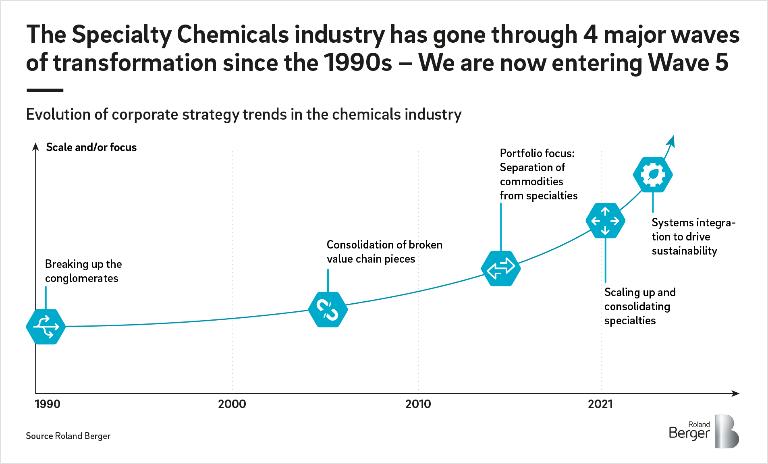

The Chemicals Industry: Cycles of Re-formation
At Roland Berger, our analysis of the chemicals industry over the last 25 years is based on waves of corporate transformation. The first wave in the late 1990s was the separation of the pharmaceutical and chemical businesses. Subsequent waves have seen value chains deconstructed (and sometimes reconstructed) as specialty and commodity business have been separated.

Additionally, our analysis is influenced by a long history of multiple cycles of industry reformation:
- 100-year Geopolitical Cycles
- 50-year Technology Cycles
- 20-year Innovation Cycles
- Generational Waves
The implications of these cycles and their lasting impact on corporate transformation is that winning players are constantly re-evaluating and clarifying the alignment between their strategies and their assets, while ensuring they maintain sufficient scale to be well followed in the capital markets.
Read on for more information on each of the cycles, and their role in shaping the waves of chemicals industry transformation. We hope this provokes some thought and conversation.
100-year Geopolitical Cycles
Political Scientist George Modelski's analysis of history (which covers a 500-year period) indicates that global leadership among nations is challenged or changed approximately every hundred years. The last time we saw global leadership change was during the first half of the twentieth century, with the U.S. replacing British dominance. U.S. leadership also followed World War I with Woodrow Wilson's role at the treaty of Versailles and his proposal for the League of Nations. Full American leadership is clearly seen following World War II, evidenced by such actions as lend lease and the Marshall plan. We are now seeing the next hundred-year cycle. Global leadership is currently being challenged as a result of the rise of China, and the fact that China is operating to a completely different economic and societal agenda than the West.
This has important implications for the chemicals industry. Chemicals is a global industry where China accounts for a third of the activity. As an industry we have tended to think that China was developing to become a market player following the economic norms of the capitalist West. We now need to take a more sophisticated and nuanced view of China's likely behavior.
50-year Technology Cycles
Nikolai Kondratiev’s analysis starts in the late 18th century, at the commencement of the industrial revolution. Examining the subsequent 250 years, he identifies broad waves of technological change each of approximately 50 years.
The cycles he identifies are holistic technological breakthroughs that fundamentally change an entire industry sector. For example, his third cycle is driven by innovation, particularly the Bessemer process. In the steel industry, when a ton of steel rail fell from $100 in 1870 to $10 per ton in 1890, the transformation had a major impact specifically on rail expansion, but it also revolutionized heavy industry.
Using Kondratiev's framework, it appears we are entering a sixth cycle. It seems likely this cycle will be driven by green technologies, which includes but is not limited to circularity, electrification, hydrogen economy, biosynthesis, and precision farming. We anticipate this also will drive a new wave of economic activity. The insight from Kondratiev's cycles is important to planners in the chemical industry. We can see this wave of innovations noted above, but we must recognize this is a long wave - fifty years. Change will slowly build over the next decades until it becomes a transformational wave, maybe the equivalent of a tsunami.
20-year Innovation Cycles
Joseph Schumpeter identified shorter cycles of approximately 20 years, driven by a force he called "creative destruction". He set out a clear process whereby an innovator's creation allows him to enjoy supernormal profits. These profits encourage imitators, which leads to the inevitable erosion of supernormal profit.
The forces Schumpeter identified are the essential engine of the capitalist system. His commentary is very instructive, as he identifies that much innovation comes from the combination of things that already exist. A clear example of this process can be seen in mobile devices where first Blackberry and then Apple transformed the simple mobile phone into a multi-functional scheduling and communication instrument. Manufacturers such as Apple and Samsung have continued to innovate by additions to their platforms, with games, cameras, and so forth. It is important that the chemical industry actively participates in these shorter waves of innovation. New products may not be new molecules, but they could be physical sales with total transparency.
Generational Waves
The concept of different generations is now part of our common parlance, but that should not lull us into complacency. Subsequent generations coming into the workforce have new and different expectations. To ensure a workforce for the future, companies will need to think about (and act on) diversity and inclusion, and articulate how they offer meaningful work. At the same time, companies will need to consider the potential impacts of generational waves on future transformation.
In conclusion, Roland Berger's review of waves and cycles reinforces the need for the chemicals industry to plan against a dynamic future. The geopolitical world is in transition; technology is being focused in sustainability; and information is transforming physical offerings. The chemicals companies who incorporate this thinking into their strategy process are more likely to win as the industry transforms.
